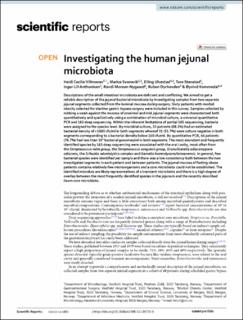| dc.contributor.author | Villmones, Heidi Cecilie | |
| dc.contributor.author | Svanevik, Marius | |
| dc.contributor.author | Ulvestad, Elling | |
| dc.contributor.author | Stenstad, Tore | |
| dc.contributor.author | Anthonisen, Inger Lill | |
| dc.contributor.author | Nygaard, Randi Monsen | |
| dc.contributor.author | Dyrhovden, Ruben | |
| dc.contributor.author | Kommedal, Øyvind | |
| dc.date.accessioned | 2022-07-05T09:20:13Z | |
| dc.date.available | 2022-07-05T09:20:13Z | |
| dc.date.created | 2022-02-07T10:20:55Z | |
| dc.date.issued | 2022 | |
| dc.identifier.issn | 2045-2322 | |
| dc.identifier.uri | https://hdl.handle.net/11250/3002712 | |
| dc.description.abstract | Descriptions of the small intestinal microbiota are deficient and conflicting. We aimed to get a reliable description of the jejunal bacterial microbiota by investigating samples from two separate jejunal segments collected from the luminal mucosa during surgery. Sixty patients with morbid obesity selected for elective gastric bypass surgery were included in this survey. Samples collected by rubbing a swab against the mucosa of proximal and mid jejunal segments were characterized both quantitatively and qualitatively using a combination of microbial culture, a universal quantitative PCR and 16S deep sequencing. Within the inherent limitations of partial 16S sequencing, bacteria were assigned to the species level. By microbial culture, 53 patients (88.3%) had an estimated bacterial density of < 1600 cfu/ml in both segments whereof 31 (51.7%) were culture negative in both segments corresponding to a bacterial density below 160 cfu/ml. By quantitative PCR, 46 patients (76.7%) had less than 104 bacterial genomes/ml in both segments. The most abundant and frequently identified species by 16S deep sequencing were associated with the oral cavity, most often from the Streptococcus mitis group, the Streptococcus sanguinis group, Granulicatella adiacens/para-adiacens, the Schaalia odontolytica complex and Gemella haemolysans/taiwanensis. In general, few bacterial species were identified per sample and there was a low consistency both between the two investigated segments in each patient and between patients. The jejunal mucosa of fasting obese patients contains relatively few microorganisms and a core microbiota could not be established. The identified microbes are likely representatives of a transient microbiota and there is a high degree of overlap between the most frequently identified species in the jejunum and the recently described ileum core microbiota. | en_US |
| dc.language.iso | eng | en_US |
| dc.publisher | Springer Nature | en_US |
| dc.rights | Navngivelse 4.0 Internasjonal | * |
| dc.rights.uri | http://creativecommons.org/licenses/by/4.0/deed.no | * |
| dc.title | Investigating the human jejunal microbiota | en_US |
| dc.type | Journal article | en_US |
| dc.type | Peer reviewed | en_US |
| dc.description.version | publishedVersion | en_US |
| dc.rights.holder | Copyright 2022 the authors | en_US |
| dc.source.articlenumber | 1682 | en_US |
| cristin.ispublished | true | |
| cristin.fulltext | original | |
| cristin.qualitycode | 1 | |
| dc.identifier.doi | 10.1038/s41598-022-05723-9 | |
| dc.identifier.cristin | 1998420 | |
| dc.source.journal | Scientific Reports | en_US |
| dc.identifier.citation | Scientific Reports. 2022, 12, 1682. | en_US |
| dc.source.volume | 12 | en_US |

